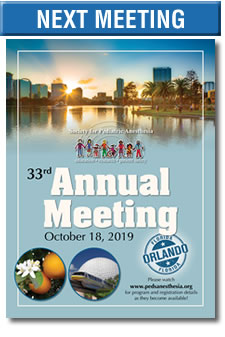SPA Meeting Reviews
Saturday Session II: Respiratory Risk in Pediatric Anesthesia: Is it Our “Bread and Butter?”
Reviewed by Dean Lao, MD, MPH
OHSU Doernbecher Children’s Hospital
 |
Dr. Lao |
This session discussed the risk of perioperative respiratory adverse events in pediatric patients receiving inhalational versus those receiving intravenous (IV) induction and strategies to mitigate that risk.
To begin the session, Britta S. von Ungern-Sternberg, MD, PhD (Perth Children’s Hospital) gave a fascinating presentation entitled “Mask and Needles- Risk and Outcomes.” There is a lot of controversy and strong opinions as to whether an inhalational or IV induction is best for pediatric patients, and this depends on multiple factors, including:
- Availability of suitable veins
- NPO status
- Surgical factors
- Usual institutional practice
Dr. von Ungern-Sternberg suggested that an inhalational induction with a gloved anesthesiologist in the OR may be more traumatic than IV placement and induction using distraction techniques. 40-60% of children experience distress during inhalational induction. Even children that appear calm during inhalational induction may have more negative memories of the event when compared to IV induction, and these memories cannot be eliminated with a subhypnotic dose of propofol after IV placement.1 Dr. von Ungern-Sternberg believes that this is because inhalational induction involves intruding into the very private space of a child’s face, while holding a limb for IV placement is better tolerated and more akin to securing a child in a car seat. As a strategy for minimizing distress, she recommends giving the child time to regain his or her composure and sense of control after IV placement before induction.
Despite this, Dr. von Ungern-Sternberg emphasized that satisfaction rates are high with both inhalational and IV induction techniques. Although IV induction is associated with a lower incidence of PONV for shorter cases, there is no difference in PONV with long procedures. Intravenous induction is faster, which results in less time spent in the induction room (for hospitals that utilize one), but there is no difference in PACU recovery times.
Perioperative respiratory adverse events (i.e. laryngospasm, bronchospasm, severe coughing, and stridor) in pediatrics account for:
- 3/4th of all critical incidents
- 1/3rd of all cardiac arrests
- ½ of all unplanned ICU admissions
- ½ of all malpractice claims
Risk factors for perioperative respiratory events in children include: asthma, passive smoking, URI within the past two weeks, low birth weight, and prematurity. Dr. von Ungern-Sternberg also emphasized the importance of screening for exercise-induced wheezing and nocturnal dry cough, since this something parents often fail to mention during the preoperative interview (and of which they may not even be aware).
Dr. von Ungern-Sternberg then described preoperative strategies to optimize anesthesia for children at risk for perioperative respiratory adverse events; the most important being the continuation of asthma medication on the day of surgery and to consider initiating treatment with beta-2 agonists and systemic/inhaled corticosteroids in at-risk patients. This is particularly useful for patients with atopy, allergy-induced wheezing, or frequent recurrent wheezing that does not coincide with URI symptoms, which is suggestive of baseline airway hyperreactivity.2
In awake children, a MDI spacer is recommended to maximize albuterol absorption. In anesthetized patients, attaching the MDI canister to a normal inline adapter is the best method for delivering albuterol. The common practices of placing the MDI canister inside a 50mL syringe on the ETCO2 connector or using a spring-loaded adapter attached to the Y-piece of the circuit are ineffective. Dr. von Ungern-Sternberg recommends avoiding sedative premedication if distraction techniques are feasible but acknowledged that practice patterns are very institution-dependent. Benzodiazepine premedication is associated with an increased risk of adverse respiratory events, whereas alpha-2 agonists such as clonidine and dexmedetomidine will reduce reflex bronchoconstriction.
Dr. von Ungern-Sternberg made a compelling case that IV induction is associated with reduced adverse perioperative respiratory events in children. She first cited the APRICOT study, a large prospective observational multicenter cohort study of 31,127 anesthetics in 30,874 children, which found on multivariate analysis a reduced risk (RR 0.78) of severe perioperative respiratory events in children (defined as laryngospasm, bronchospasm, desaturation, or airway obstruction) receiving IV induction compared to inhalational.3 She then discussed “Inhalational versus Intravenous Induction of Anesthesia in Children with a High Risk of Perioperative Respiratory Adverse Events,” a single-center randomized controlled trial of 300 children published in Anesthesiology.4 Study participants were required to be zero to eight years old and have 2 or more of the following risk factors of perioperative respiratory adverse events:
- URI £ 2 weeks
- Wheezing £ 12 months
- Wheezing at exercise
- Nocturnal dry cough
- Eczema (past/present)
- Passive smoking (parent or caregiver)
- Family history of hay fever/asthma/eczema
Patient demographics were similar between groups, with an approximate 60% male, 40% female gender distribution and median age of four years in each group. 149 patients were analyzed in the inhalational sevoflurane group and 149 in the IV propofol group. Eight patients crossed over from the IV to inhalational group (due to EMLA cream not being applied long enough), while six patients crossed over from the inhalational group to the IV group (due to fear or aversion to the face mask). Patients in the inhalational sevoflurane group had an overall increased risk of perioperative adverse respiratory events compared to IV propofol (43% vs. 26%, RR: 1.7, P= 0.002). This increased risk persisted during all phases of the anesthetic and was most pronounced during induction (32% vs. 11%, RR: 3.06, P< 0.001). Dr. von Ungern-Sternberg also noted that 49% of patients in the inhalational group received an additional dose of IV propofol before airway management, which is a common clinical practice, but this did not reduce the risk of adverse respiratory events.
Dr. von Ungern-Sternberg concluded her presentation by emphasizing the need to keep an open mind and challenge traditions by considering an IV propofol induction to minimize the risk of adverse respiratory events, particularly in patients with URI. Even though children may have more anxiety during IV induction, they generally have fewer postoperative behavioral issues, which may ultimately be more important to parents and caregivers.
The session concluded with “WWSPAD: What Would SPA Members Do?,” an interactive review of three clinical vignettes of patients at risk for perioperative respiratory adverse events presented to both the audience and an expert panel consisting of Dr. von Ungern-Sternberg, Shobha Malviya, MD, FAAP (University of Michigan), and Joseph Cravero, MD (Boston Children’s Hospital). Overall, the audience was mixed as to whether to proceed with each case and in their anesthetic management of each case. The entire expert panel agreed that preoperative albuterol was an important strategy in reducing the risk of respiratory complications. Drs. Malviya and Cravero preferred endotracheal intubation for the patients presented, stating that they would rather deal with any respiratory complications during emergence/extubation as opposed to during the actual procedure. In contrast, Dr. von Ungern-Sternberg advocated using IV propofol for both induction and maintenance and LMA with deep removal to reduce respiratory risk for the two sample patients presented that were having adenotonsillectomy and PE tubes/adenoidectomy.
References
- Kotiniemi LH, Ryhanen PT. Behavioral changes and children’s memories after intravenous, inhalation and rectal induction of anaesthesia. Paediatric Anaesthesia 1996; 6:201-207.
- von Ungern-Sternberg BS et al. Peri-operative adverse respiratory events in children. Anaesthesia 2015; 70:440-444.
- Habre W et al. Incidence of severe critical events in paediatric anesthesia (APRICOT): a prospective multicenter observational study in 261 hospitals in Europe. Lancet Respir Med 2017; 5:412-25.
- Ramgolam A et al. Inhalational versus Intravenous Induction of Anesthesia in Children with a High Risk of Perioperative Respiratory Adverse Events. Anesthesiology 2018; 128:1065-74






